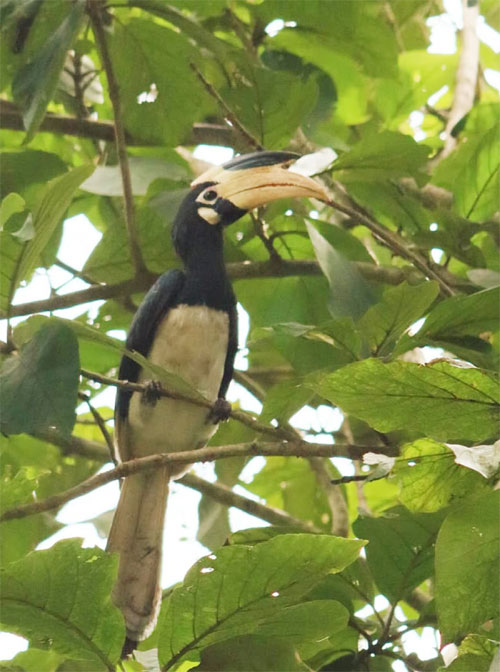Daijiworld Media Network – Udupi
Udupi, Oct 1: The Malabar Pied Hornbill, a striking forest-dwelling bird more commonly seen in the dense canopies of the Western Ghats, is now making unexpected appearances in urban areas of Udupi, sparking excitement among birdwatchers and wildlife enthusiasts alike.
Spotted in places such as Brahmagiri and Ambalpady, these hornbills have been seen perched on tall city trees—an unusual sight that has turned the heads of both residents and naturalists.
While the species is not new to the Udupi district, ornithologists say its increasing presence within city limits is both surprising and noteworthy.

“Malabar Pied Hornbills are typically seen deep inside forested landscapes. Their arrival in urban zones is unexpected and definitely worth paying attention to,” said local birdwatchers observing the trend.
Forest giants move to the city
Known for their bold black-and-white plumage and curved, yellow-black beaks, the Malabar Pied Hornbill is usually found in evergreen and moist deciduous forests, particularly along riverbanks. Their diet includes fruits, small animals, insects, and even reptiles, but they are especially fond of figs, which may be drawing them into fruiting city trees during specific months.
The species is also famous for its unusual nesting habits. During breeding season, the female hornbill seals herself inside a tree cavity using a mixture of her own droppings and mud, leaving only a narrow slit open. Through this, the male delivers food until the chicks are ready to leave the nest.
Experts warn, however, that rapid habitat loss and deforestation have led to a decline in hornbill populations across the Western Ghats.
‘They may be nesting here now’
“There is a strong possibility that these hornbills have now found a permanent nesting habitat in Udupi, particularly in tree hollows on large trees located on the city’s outskirts,” said Tejaswi S. Acharya, trustee of the Manipal Birding and Conservation Trust.
“We’ve even seen them roosting on the Makada tree near Udupi city bus stand. Our birdwatching team has encountered them several times in recent months,” he added.
Not just passing visitors
Bird expert V Lakshminarayana Upadhyaya noted that hornbills were once only seen after long trips to places like Dandeli, deep in the Western Ghats. But that has started to change.
“For the past three to four years, we’ve been spotting groups of Malabar pied hornbills in urban areas like Kundapura and Udupi. They’re not present throughout the year, but are especially visible during August and September, likely drawn by fruiting trees,” he said.
He also pointed out that increased human interference in their native forest habitats could be pushing the birds toward the coastal belt, where tall trees and seasonal food sources are still available.
Urban sightings: A conservation alarm or adaptation?
The hornbills’ shift into Udupi city areas is being seen as both a welcome development for local wildlife lovers and a warning sign of habitat displacement. Their presence in urban zones may indicate adaptive behaviour—or more worryingly, a retreat from threatened forest ecosystems.
With sightings now reported over consecutive years, bird experts believe this could mark a long-term behavioural shift, and stress the need for urban tree conservation to support species adapting to changing environments.